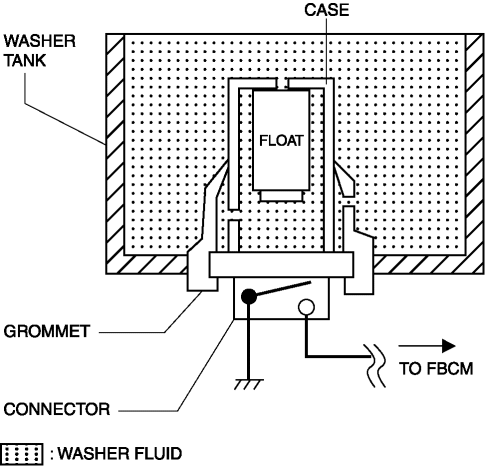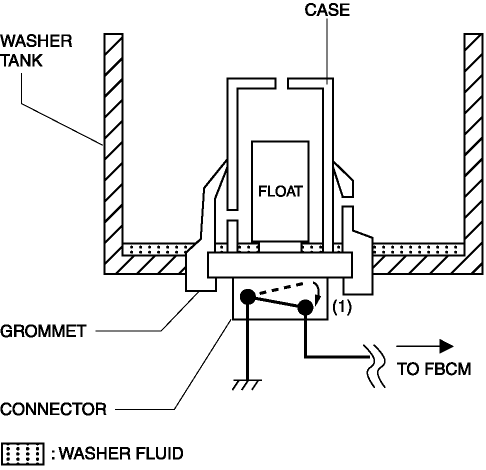Mazda CX-5 Service & Repair Manual: Washer Fluid Level Sensor
Purpose
-
The washer fluid-level sensor illuminates the low washer fluid level warning light when the washer fluid level is lowered.
Function
-
The washer fluid-level sensor detects the decrease in the washer fluid level.
Construction
-
The washer fluid-level sensor consists of the following parts:
-
Connector (switch)
-
Float
-
Grommet
-
Case
-
The float has an integrated magnet which creates a magnetic field.
Operation
When washer fluid is added
1. Washer fluid enters the case of the washer fluid-level sensor, the float rises, and the connector switch turns off.

When washer fluid is decreased
1. When washer fluid inside the case of the washer fluid-level sensor decreases, the float comes close to the connector switch.
2. When the float approaches the switch, the magnetic field inside the float acts on the switch and the switch turns on. (1)

3. When the switch is turned on, the front body control module (FBCM) detects that the washer fluid level is lowered (2) and sends a low washer fluid level warning light illumination request signal to the instrument cluster as a CAN signal. (3)
4. When the instrument cluster receives the low washer fluid level warning light illumination request signal, it illuminates the low washer fluid level warning light. (4)

Fail-safe
-
Function not equipped.
 Windshield Washer Nozzle Removal/Installation
Windshield Washer Nozzle Removal/Installation
1. Remove the following parts:
a. Windshield wiper arm and blade.
b. Cowl grille.
2. Disconnect the windshield washer hose from the windshield washer nozzle..
3. While pressing windshield was ...
 Washer Fluid Level Sensor Inspection
Washer Fluid Level Sensor Inspection
1. Disconnect the negative battery cable..
2. Set the front over fender aside..
3. Set the mudguard (RH) aside..
4. Remove the front bumper..
5. Inspect for continuity according to washer flui ...
Other materials:
Front Combination Light Disassembly/Assembly
1. Disassemble in the order shown in the figure.
Halogen type
1
Short cord
(See Short Cord Removal Note.)
2
Parking/Front turn light bulb
(See PARKING/FRONT TURN LIGHT BULB REMOVAL/INSTALLATION.)
3
Headlight ...
Plastic Parts Heat Resisting Temperature [Plastic Body Parts]
Part Name
Code
Material Name
Heat resisting
Temperature°C{°F}
Windshield molding
PVC
POLYVINYLCHLORIDE
95 {203}
Cowl grille
PP
POLYPROPYLENE
...
Rear Side Marker Light Bulb Removal/Installation
1. Disconnect the negative battery cable..
2. Insert a tape-wrapped flathead screwdriver into the service hole in the position
shown in the figure.
3. Move the flathead screwdriver in the direction of the arrow (1) shown in the
figure, pull out the service hole cover, and detach the serv ...
